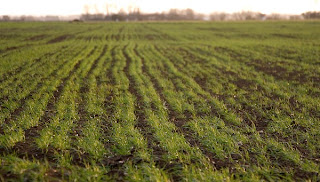 When flying with a single engine aeroplane, we have to be prepared to the engine failure situation. In this case, the solution is an off field landing, which means gliding to a field without power.
When flying with a single engine aeroplane, we have to be prepared to the engine failure situation. In this case, the solution is an off field landing, which means gliding to a field without power.It could look like obvious but the ideal field choice is in fact a discipline included in the flying skills.
The problem is: there are many fields but even if the failed engine aircraft keeps on flying, the available reaction time is very short (3 minutes between engine loss and landing is a lot) and some obstacles are very hard to detect from above, like power lines.
The pictured field would be a perfect choice for an off field landing: flat, large, short grass, small furrows, no power line or fence in the vicinity, not far from a village,...
Unfortunately it has a very low probability of being elected as best off field landing place. It is indeed located just aside Merville airport in the North of France, and even with a failed engine, a runway remains the best place to land an airplane.
I would need to have more than one engine on my aircraft to become less concerned by fields ... later I hope!






